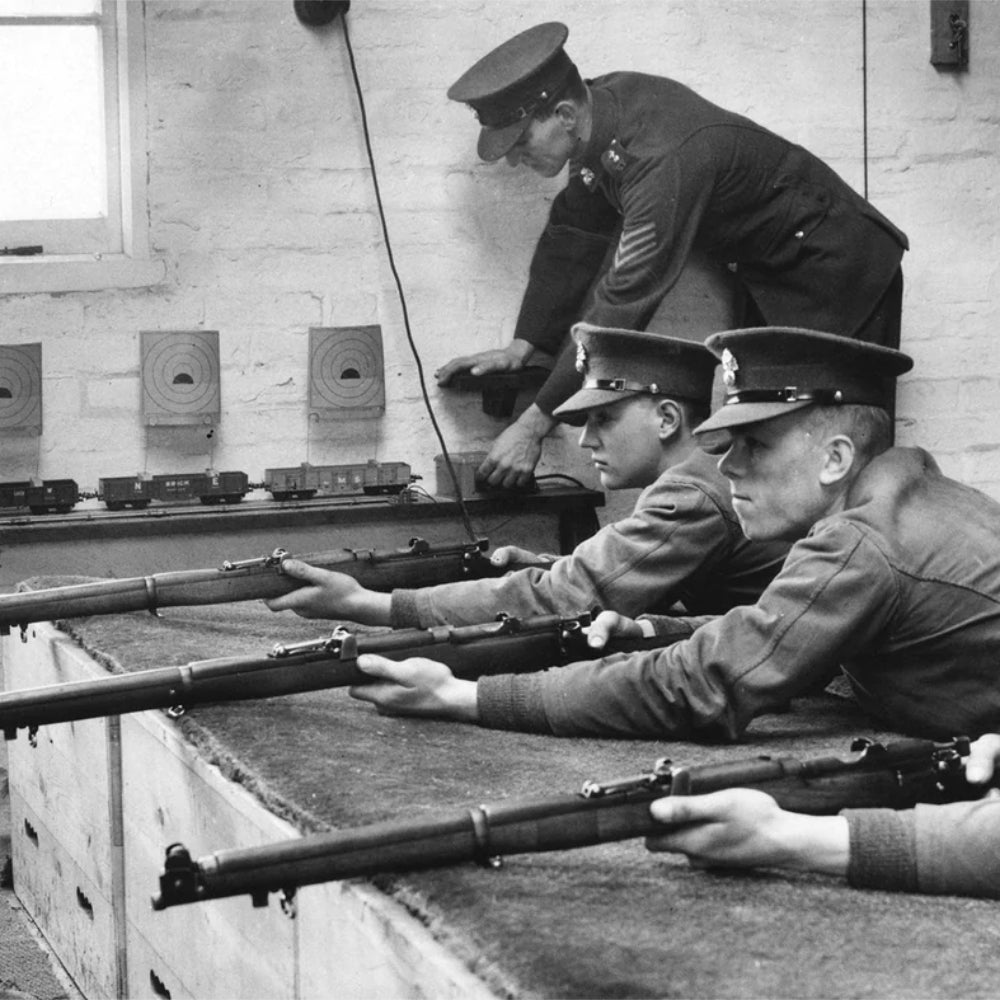Free Shipping on Canadian orders over $175
Free Shipping on Canadian orders over $175

A (Brief) History of the Lee Enfield Rifle
August 29, 2023 6 min read
A Rifle's Odyssey
In the pantheon of firearms, few rifles hold a place as esteemed as the Lee Enfield. This is not just a tale of wood and steel, but a story that traverses epochs, cultures, and continents. The Lee Enfield's odyssey begins in the industrial fires of the 19th century, forging a path through the world's most defining conflicts.
Birth and Early Days
Design and Genesis
The Lee Enfield emerged from the mind of James Paris Lee, an innovative firearms designer. Born in Hawick, Scotland, on August 9, 1831, Lee immigrated to Canada with his family in 1836, settling in Galt, Ontario. From an early age, he displayed an aptitude for mechanical tinkering, especially in the realm of firearms.
Lee’s ingenuity led to several patents. His interest in firearms was not limited to mere tinkering; he sought to revolutionize rifle design. One of his first major inventions was the “Lee” magazine, a detachable box magazine that was groundbreaking for its time.
This magazine system allowed for faster reloading and increased ammunition capacity, providing soldiers with significant advantages on the battlefield. It was an idea well ahead of its time, reflecting Lee’s vision and inventive prowess.
The collaboration between James Paris Lee and the British Royal Small Arms Factory in Enfield led to the creation of the Lee Enfield rifle. Lee’s bolt-action design and magazine system were married with Enfield’s barrel and sighting arrangements to create a firearm that would become a symbol of military excellence.
The British Army, on the lookout for a weapon that combined firepower with reliability, found the answer in Lee's design. Adopted in 1895, this bolt-action rifle’s ten-round magazine made it revolutionary.
The early models underwent several refinements. The creation of the Short Magazine Lee Enfield (SMLE) in 1904 signalled a turning point, embedding the rifle's name in military lexicon. The SMLE was compact, robust, and designed for the rigours of modern warfare.
Early trials exposed flaws that required attention. There were concerns about the barrel's strength, the bolt's mechanism, and the sights. The British Army's Ordnance Board worked diligently to address these, resulting in a weapon that was both sophisticated and soldier-friendly.
Trenches and Mud
World War I introduced the Lee Enfield to the unforgiving trenches of the Western Front. Mud, rain, and brutal conditions tested the rifle, but the SMLE's design prevailed in many battles against its main rival the German Gewehr 98. Its shorter design (and as a result its maneuverability) and fast rate of fire largely compensated for its shorter range compared to the Gewehr. From the Somme to Vimy and virtually anywhere else there was an engagement, it built a fan base among the troops because of its adaptability, being equally at home clearing trenches to sniping.
One interesting side note that came about because of the very specific strengths of the rifle was the "Mad Minute" exercise; where soldiers aimed to fire 15 aimed shots in a minute. Overall in the hands of skilled riflemen, the Lee Enfield became a symbol of Commonwealth firepower.
Beyond the Western Front the Lee Enfield saw action in virtually every theatre from the scorching sands of Mesopotamia to the rugged heights of Gallipoli, this rifle was a constant companion to British and Commonwealth forces.
Between Wars
The interwar years were a time of reflection and refinement for the Lee Enfield. Lessons from the battlefield led to modifications, streamlining production without sacrificing quality. Training rifles, like the No. 2 Mk IV, emerged to equip new generations of soldiers. Beyond the military, the Lee Enfield saw action policing the far reaches of the British Empire. In India, Ireland, and other colonial territories, it became a symbol of authority, reinforcing British control and influence.
A Rifle Reborn: No. 4 Mk I
With the looming clouds of World War II, the British Army sought to adapt the Lee Enfield to the modern battlefield. The No. 4 Mk I was introduced, embodying the lessons of the past. With simplified production and enhanced features, this new variant was poised for war.
At the chaotic beaches of Dunkirk, the Lee Enfield was a stalwart defender, providing covering fire against relentless German advances as British and allied forces conducted a harrowing evacuation earning respect in the most desperate circumstances. And when D-Day arrived, the Lee Enfield was part of the monumental landings, and proved startlingly adaptable in the hands of the Commonwealth soldier travelling from the storm-lashed beaches of Normandy to the dense hedgerows of the French countryside.
Its presence was felt across Europe, in battles such as Arnhem, where paratroopers depended on its rugged reliability, and the Battle of the Bulge, where it faced the harsh winter and a determined enemy while it also saw action in the searing heat of North Africa. The desert was a landscape of extremes, and both men and rifles were pushed to their limits. At El Alamein, a decisive battle that turned the tide against the Axis, the Lee Enfield was there the same as it was in the mountainous terrain of Italy.
Beyond the traditional European theatre, the Enfield found itself in a scenario virtually unthinkable today. Along the Eastern Front through Lend-Lease agreements with the Soviet Union, it fought in the hands of Russians. Though not their primary rifle, the Soviets appreciated its qualities, using it in various capacities as it bolstered the Soviet’s always limited supply of weapons to arm what seemed like an infinite supply of disposable lives.
In the dense jungles of the Pacific, where close combat was common, the Lee Enfield also served alongside other Commonwealth forces, such as the Australians. It proved suitable for the humid, harsh environment, engaging Japanese forces in climate every bit as foreign as the African desert and Italian mountains.
Post-War Transformations
A Surplus Legacy
The end of World War II left a massive surplus of Lee Enfield rifles. They were far from obsolete, and various militaries continued to use them. Yet, an interesting transformation awaited the Lee Enfield: the transition from military service to civilian life.
Sporterizing: A New Life
Farmers, hunters, and sporting enthusiasts saw potential in these often familiar surplus rifles. A process known as "sporterizing" began, where military features were removed or modified, and the rifle was adapted for civilian purposes. This resulted in the much more familiar sporterizing stock that can be found in virtually every collection in Canada. The sporterization was so ubiquitous that these days a full stock Lee Enfield is valued at several times its sporterized brother. The new life it enjoyed though is almost singular for military rifles and adapted handily to the hands of civilians who appreciated its reliability, accuracy, and historical significance. From the battlefields to the hunting fields, this transformation marked a unique chapter in the rifle's storied existence.
Cold War and Contemporary Conflicts
The Lee Enfield did not retire entirely into its post-service hunting period with the end of the Second World War though. Lacking an update for the modern era, several forces including Canada used its Enfields a few years later amidst the frostbitten hills and valleys of Korea. The biting cold was a harsh test for the firearm, but the Lee Enfield's robust if aged design once again demonstrated its adaptability and reliability in what would be its last major deployment.
As the British Empire unraveled, the Lee Enfield found itself in the hands of both colonial authorities and those fighting for independence. From the Mau Mau Uprising in Kenya to conflicts in Malaya, the rifle was visible in the hands of soldiers on both sides of the struggle.
Anti-Terror Operations
Despite celebrating almost one hundred years in service, the poor Enfield still didn’t receive its much deserved retirement, being adapted and modified for use in specialized roles such as sniping and marksmanship by various forces in anti-terror and peacekeeping operations right up to the latter half of the 20th century.
Collector's Item and Living History
In the hands of collectors, historians, and enthusiasts, the Lee Enfield became more than a piece of antiquated military hardware. It evolved into a living artifact, a tangible link to the past that continues to fascinate and educate.
Its presence in historical reenactments, museums, and private collections ensures that the legacy of the Lee Enfield remains vibrant and accessible to new generations.
The sporterized Lee Enfield continues to thrive in the civilian market. Farmers and sportsmen, especially in places like Canada, found its characteristics appealing. Hunting, target shooting, and recreational use kept the rifle active, further enhancing its multifaceted legacy.
The Lee Enfield's journey from the drawing board to the battlefields, and eventually to the hearths and fields of civilians, is a rich tapestry of history, engineering, and human endeavour. It has played roles as diverse as protector, enforcer, liberator, and sportsman. Its Canadian connection, through both military service and civilian enjoyment, resonates with the ethos of adaptability, resilience, and respect for heritages that we pride ourselves.
The Lee Enfield is not merely a rifle; it's an embodiment of a time, a philosophy, and a way of life. It stands as an enduring icon and a symbol of a bygone era that continues to echo in the chambers of history. I hope you’ve enjoyed our (brief) visit with this legendary rifle and if you’d like to dig deeper, take moment to visit our library where we have a large collection of historical books dealing with the Lee Enfield as well as its contemporaries.
Leave a comment
Comments will be approved before showing up.
We clean up after ourselves.
Ecommerce deliveries have a carbon footprint. That's why we support verified projects that remove carbon from the air.



Every delivery’s carbon footprint is calculated based on weight, shipping method, and distance traveled. We neutralize these emissions by purchasing verified carbon removal credits from groundbreaking projects.



With your purchase, you’ll join a community of proactive merchants and customers dedicated to a sustainable future. Together, we've removed emissions for over 52 million deliveries and removed over 38 thousand tonnes of carbon.

We work with a network of pioneering carbon removal companies that have been vetted by the commerce platform Shopify.

